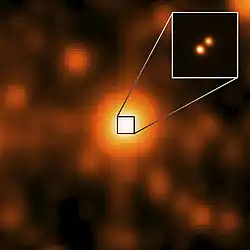Kepler-68d
Kepler-68d is a gas giant with the minimum mass about the same as Jupiter. It is at least a jovian-mass planet orbiting 1.4 astronomical units from its parent star, Kepler-68, well within habitable zone of the star.[2] It was detected by radial velocity.[3]
| Discovery | |
|---|---|
| Discovery date | February 12, 2013 |
| Radial velocity | |
| Orbital characteristics | |
| Periastron | 1.148 AU |
| Apoastron | 1.652 AU |
| 1.4±0.03 AU[1] | |
| Eccentricity | 0.18 ± 0.05 |
| 580±50 d | |
| Physical characteristics | |
| Mass | ≥0.947 Mj |
After planets Kepler-68b and c were detected by observing planetary transits in front of its star, doppler spectroscopy measurements were used to make follow-up observations of the star. Kepler-68d was discovered using that method.
References
- "Kepler Discoveries". kepler.nasa.gov. Retrieved February 26, 2013.
- Gilliland, Ronald L.; et al. (2013). "Kepler-68: Three Planets, One with a Density Between That of Earth and Ice Giants". The Astrophysical Journal. 766 (1). 40. arXiv:1302.2596. Bibcode:2013ApJ...766...40G. doi:10.1088/0004-637X/766/1/40.
- Exoplanet. "Planet Kepler-68 d". Exoplanet.eu. Archived from the original on 16 February 2014. Retrieved 28 February 2013.
External links
- Table of confirmed planets at NASA, Kepler mission
This article is issued from Wikipedia. The text is licensed under Creative Commons - Attribution - Sharealike. Additional terms may apply for the media files.



